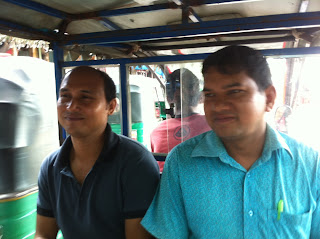We spent today at a couple of the sister organisations of the Bank. First, it was a visit to Grameen Shakti, an organisation seeking to provide renewable electricity and energy to the rural poor, largely off the national grid, which is currently 47% of the population. Even those 53% with coverage suffer from almost daily power outages.
The company has been operating since 1996, and has so far installed solar panels in over a million homes, an incredible feat earning the company numerous international awards. It hopes to reach its second million by 2015, currently installing c.25,000 systems each month. That 46 other organisations have only implemented one million solar panels between them puts this achievement into perspective.
There are obvious benefits to the provision of renewable energy to rural areas. Namely the improvement of vital services such as healthcare and education. Access to light also extends business hours, a vital aid to the survival of some of Bangladesh’s poorest citizens. Solar power is also used to aid agriculture in controlling irrigation systems, and to power telecommunication towers across the country.
The operation is also driving real social change in the form of female empowerment. Grameen Technology Centres, responsible for the installation and maintenance of the power supply, are operated by 150 female engineers, with a further 3,000 local female technicians trained.
There are a number of loans available with differing levels of downpayment, interest rates and repayment periods based on personal situation and the size of the solar panel purchased. Grameen Shakti boasts an incredible 95% recovery rate of these loans, suggesting that the electricity offered is having a real impact upon the successful practice of rural business and agriculture.
Grameen Shakti also operates two other main projects, one for the provision of biogas, largely made from manure, and the other the provision of Improved Cooking Stoves. To date, the company has provided rural areas with 25,619 biogas plants, each serving different sized groups or families. There are obvious immediate benefits to this for the families, namely a cheaper supply of energy, and certain global benefits, such as reduced demand for non-renewable resources. There is, however, the obvious downside that the methane produced has four times the global warming potential per particle as carbon dioxide.
The Improved Cooking Stoves offer a cooking solution using less biomass, producing less emissions, and creating a healthier indoor cooking environment, with a pipe to extract smoke produced in cooking. To date, over 261,000 have been installed.
A recent Environmental Impact Assessment on the collective projects has shown staggering results for carbon emission reduction. Thus far, 124.26 million litres of kerosene have been saved, equating to $109million. The total emission reduction comes in at a cool 293,262 tonnes of C02 per year! The obvious benefit to Bangladesh, though not necessary the environment, is that the country can now sell on any carbon credits saved.
The operation has amazing opportunities to expand, and even greater opportunities for replication. There seems to be no good reason why such a system cannot operate in more developing countries of a similar climate, the system is a win-win for almost all involved. We were told the project is indeed being replicated, in countries such as Nepal, though seemingly at no great speed.
The project can (and must, though in perhaps a different form) now spread to urban areas, where the consumption of, and cost of using, non-renewable energy is staggering. The company claim to want to address areas without any energy first, but I’m sure there is no harm in starting to plan an approach to urban areas that can see solar-power and biogas replace alternative forms of energy generation. Indeed, Grameen Shakti has already introduced a huge biogas plant 24km from Dhaka, with agreements in place with various rural municipalities to provide manure.
The work of Grameen Shakti is amazing and must continue, even broadening to cover other questions of sustainability and environmental degradation. I need to learn more about all of the projects Shakti is undertaking to make a more full analysis, but from what we learnt today there is certainly more that it can do, on a social business and NGO level. A fund for green entrepreneurship, encouraging sustainable small businesses in rural areas, supporting sustainable forestry, tightening protection of national parks and thus wildlife conservation, and improving recycling facilities are all potential projects for the future (though of course based on an imperfect knowledge of current projects).








